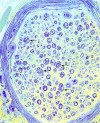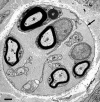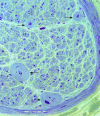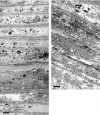The role of glycation in the pathogenesis of diabetic polyneuropathy
- PMID: 11724915
- PMCID: PMC1187130
The role of glycation in the pathogenesis of diabetic polyneuropathy
Abstract
The most common neuropathy associated with diabetes mellitus is a distal sensory polyneuropathy. The relative importance of the direct effects of prolonged glycaemia on nervous tissue compared with indirect damage resulting from changes in blood vessels is not known. Although the importance of glycaemia is confirmed by a study showing that the incidence of neuropathy is greatly reduced by strict glycaemic control, many of the details of the deleterious effects of glycaemia on the peripheral nervous system (PNS) are not understood. These may be the result of direct damage to any of the cells in the PNS or the disruption of neuronal metabolism, axonal transport mechanisms, or repair capabilities; in addition, they may result from the effects of glycation on PNS connective tissue or a combination of some or all of the above mentioned mechanisms. The relative importance of these various mechanisms by which diabetes damages the PNS is a matter of conjecture. Therapeutic approaches targeting a specific mechanism such as those utilising aldose reductase inhibitors, or advanced glycation endproduct inhibitors have met with limited success. Clearly, it is difficult to design a treatment for diabetic neuropathy while its pathogenesis is still poorly understood.
Figures





Similar articles
-
Pathogenesis of diabetic neuropathy: role of altered phosphoinositide metabolism.Crit Rev Neurobiol. 1989;5(2):143-219. Crit Rev Neurobiol. 1989. PMID: 2561904 Review.
-
Blood-Nerve Barrier (BNB) Pathology in Diabetic Peripheral Neuropathy and In Vitro Human BNB Model.Int J Mol Sci. 2020 Dec 23;22(1):62. doi: 10.3390/ijms22010062. Int J Mol Sci. 2020. PMID: 33374622 Free PMC article. Review.
-
Fiber loss is primary and multifocal in sural nerves in diabetic polyneuropathy.Ann Neurol. 1986 May;19(5):425-39. doi: 10.1002/ana.410190503. Ann Neurol. 1986. PMID: 3717906
-
Schwann cell interactions with axons and microvessels in diabetic neuropathy.Nat Rev Neurol. 2017 Mar;13(3):135-147. doi: 10.1038/nrneurol.2016.201. Epub 2017 Jan 30. Nat Rev Neurol. 2017. PMID: 28134254 Free PMC article. Review.
-
[Ultrastructural study of pheripheral nerve in 16 diabetics without neuropathy. Comparisons with 16 diabetic neuropathies and 16 non-diabetic neuropathies (author's transl)].Acta Neuropathol. 1974;30(1):63-72. doi: 10.1007/BF00685323. Acta Neuropathol. 1974. PMID: 4446960 French. No abstract available.
Cited by
-
Exploring the role of miRNA in diabetic neuropathy: from diagnostics to therapeutics.Naunyn Schmiedebergs Arch Pharmacol. 2025 Feb;398(2):1129-1144. doi: 10.1007/s00210-024-03422-y. Epub 2024 Sep 9. Naunyn Schmiedebergs Arch Pharmacol. 2025. PMID: 39249503 Review.
-
Antioxidant strategies in the management of diabetic neuropathy.Biomed Res Int. 2015;2015:515042. doi: 10.1155/2015/515042. Epub 2015 Mar 2. Biomed Res Int. 2015. PMID: 25821809 Free PMC article. Review.
-
Upper gastrointestinal sensory-motor dysfunction in diabetes mellitus.World J Gastroenterol. 2006 May 14;12(18):2846-57. doi: 10.3748/wjg.v12.i18.2846. World J Gastroenterol. 2006. PMID: 16718808 Free PMC article. Review.
-
Increased accumulation of skin advanced glycation end-products precedes and correlates with clinical manifestation of diabetic neuropathy.Diabetologia. 2005 Aug;48(8):1637-44. doi: 10.1007/s00125-005-1828-x. Epub 2005 Jul 14. Diabetologia. 2005. PMID: 16021416
-
New insights into the mechanisms of diabetic neuropathy.Rev Endocr Metab Disord. 2004 Aug;5(3):227-36. doi: 10.1023/B:REMD.0000032411.11422.e0. Rev Endocr Metab Disord. 2004. PMID: 15211094 Review. No abstract available.
References
-
- Diabetes Control and Complications Trial Research Group. The effect of intensive treatment for diabetes on the development and progression of long-term complications in insulin-dependent diabetes mellitus. N Engl J Med 1993;329:977–86. - PubMed
-
- Gaede P, Vedel P, Parving HH, et al. Intensified multifactorial intervention in patients with type 2 diabetes mellitus and microalbuminuria: the Steno type 2 randomised study. Lancet 1999;353:617–22. - PubMed
-
- Bradley JL, Thomas PK, King RHM, et al. Myelinated fibre regeneration in diabetic sensory polyneuropathy: correlation with type of diabetes. Acta Neuropathol (Berl) 1995;90:403–10. - PubMed
-
- Shaklai N, Garlick RL, Bunn HF. Nonenzymatic glycosylation of human serum albumin alters its conformation and function. J Biol Chem 1984;259:3812–17. - PubMed
-
- Sell DR, Nagaraj RH, Grandhee SK, et al. Pentosidine: a molecular marker for the cumulative damage to proteins in diabetes, aging, and uremia. Diabetes Metab Rev 1991;7:239–51. - PubMed
Publication types
MeSH terms
Substances
LinkOut - more resources
Full Text Sources
Medical
Miscellaneous
